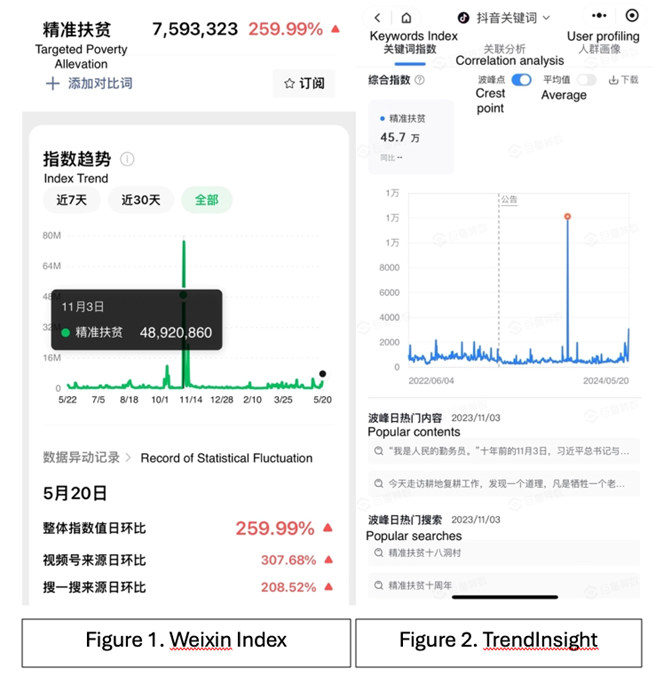Digital Mapping of Chinese Catchwords

By Xumeng Xie (Lecturer in Chinese Studies and Digital Cultures, QMUL)
Author's Note: Professor Suman Gupta and I have had discussions about launching a blog focusing on Chinese catchwords or catchphrases (中文流行语 which include both words and phrases). Suman has previously written this useful post to reflect on what he thinks the defining features for a catchword/phrase would be and the significance of having some analytical tools to quantify its usage frequency within or across domains during a period of time. In this post I hope to draw up some overlapping interests and questions arising from our previous discussions around what we intend to achieve from this specific project. Moreover, this post will also outline a few contextual and methodological issues in relation to studying Chinese catchwords/phrases primarily from a media studies perspective.
The broad vision for this forthcoming blog is to open up a collaborative space for writing and debating about catchwords/phrases emerging from Chinese contexts and how they inform our understandings about Chinese cultures and societies. For the scope of context, I am taking mainland China and Mandarin Chinese as a starting point here because of the limitation of my own cultural knowledge and linguistic capabilities. However, in the future we will welcome posts and contributions that concern and analyse catchwords from other regions, countries, societies and minority ethnic or diasporic communities that use Chinese languages to question the dominance of Mandarin Chinese in an increasingly transnational Sinophone world (Shih, 2011).
Does a catchword ‘flow’ or not?
In Dr Wang Yusu’s notes about keywords and catchwords, it was noted that the metaphorical implication of 流行 as ‘an overflowing river’ was lost when it became a component of the term “流行语”. This is helpful for those who do not understand Chinese. According to 现代汉语词典》 (A Dictionary of Current Chinese), 流行 is defined as something ‘widespread’ or ‘prevailing’. Whether it is flowing or spreading, this term carries a sense of being out of control, which seems different from the notion of catchwords in English – to catch or to be caught suggests a firm action of contact with more concrete objects. This notion of flowing or spreading, however, can be linked to the imagination of digital networks, especially considering that biological analogies and medical metaphors, such as memes and virality, continue to be debated and conceptualised by media scholars (Sampson, 2012; Shifman, 2014). In the digital age, what we see in online communication are the assemblages of texts, images, artefacts, feelings and affects. Thus, a catchword/phrase can also evolve into other forms or incorporate other visual-audio elements, making it easily recognisable, replicable and spreadable, potentially catching on with the wider population.
Dr Wang Yusu also shared their approach to keywords as one of the main contributors to Breaking the Wall–Keywords in Chinese Internet Subcultures, which is a groundbreaking dictionary produced by academics devoted to understanding online (sub)cultures in China. I noticed an interesting territorialisation suggested in both the title of the book and Yusu’s notes where online interactions appear to be separated from an offline ‘real world’ to a certain extent. Following this line of thought, some catchwords that emerge from the online sphere hence ‘offer limited insights into social reality’, whereas keywords that are carefully selected and curated demonstrate ‘real explanatory power’. This raises several questions for me:
- Are these internet subcultures and communities not part of the social reality?
- When and how can we determine if a catchword has entered into the broader realm of everyday communication or not?
- Why does it matter?
Linking back to Suman’s blogpost, the recognition of catchwords often starts with a perceptual estimation, which can be subject to suspicion or dismissal for its reliance on subjective observation. On the other hand, working with corpora represents another approach to measuring the usage frequency of a specific word/phrase within a given time-period. Ideally, if we identify a notable increase in its usage frequency, this word/phrase could be identified as a catchword/phrase.
Working with imperfect tools
In practice, the problem with applying this quantitative approach to studying Chinese catchwords/phrases is first met with the difficulty in finding an easily accessible, frequently updated and reliable large-scale corpus of Modern Chinese. The best one that I could access is Peking University CCL Online Corpus, which mainly gathers data from online archives of modern literature, news reports, government policies, blogs, public accounts on social media, etc. Although I share a keen interest in digital and youth cultures, I disagree with Yusu’s assertion that traditional media rarely helped to create catchwords. On the contrary, it is common to observe the emergence of a ‘catchword’ before the prevalence of internet in China. One notable example is the Spring Festival Galas, which have been a staple for celebrating Chinese New Year and are broadcast nationwide since the 1980s. Words and phrases from traditional comedy performances (especially xiaopin) often got disseminated via mass media and then ‘caught on’ with the general public. The xiaopin artist Zhao Benshan is famous for his ability to create those catchwords/phrases.
Digital technologies and the internet have brought about the digitisation of language corpora and methodological innovations, enabling the use of corpus-assisted methods to analyse online discourses (Koteyko, 2015). In addition, there are a few digital tools with similar affordance of tracking the usage frequency of certain words or phrases in Chinese context, but a few more notes are warranted here. In Wang Yusu’s notes, she mentioned 微博热搜 (the most searched terms on Sina Weibo updated per minute) and 年度弹幕 ‘danmu of the year’ of Bilibili (a video sharing platform popular among younger population). Since major social media platforms profit from (making sense of) user generated data and contents (Dijck, 2013; Fuchs, 2015), tools like these are usually developed by social media platforms and thus focus on tracking the data and contents generated and/or circulated through their own platform. Taking another example, Sina Weibo, the most popular microblogging site in mainland China and regularly referred to as the Chinese version of Twitter (now X), has a data analysis tool called Weizhishu (Weibo Index, currently restricted from access). This tool aims to provide a more ‘comprehensive representation’ of the popularity of specific keywords by quantifying mentions, reads and other interaction data on the Weibo platform and ‘serves the need for researching public opinion’ through ‘capturing hot social events and hot topics’.
Similarly, Weixin (domestic version of WeChat) offers an embedded mini program called Weixin Index, which reflects ‘the change in popularity of a given keyword within the Weixin platform’ based on ‘a comprehensive analysis of Weixin searches, public account articles, and publicly forwarded articles in Weixin Moments’. Ocean Engine, a digital marketing service platform owned by Tiktok’s parent company Bytedance, also launched a tool called TrendInsight. This tool enables ‘inquiries into the popularity trends in the ecosystems of content consumption and to conduct multi-end “hot words” index search for platforms such as Douyin and Toutiao, as well as in-depth analysis into relevant hot spots using correlation analysis and user profiling’.
In order to try out Weixin Index and Trend Insight, I searched for the phrase ‘Targeted Poverty Alleviation’, which according to my subjective observation has become quite a political catchphrase since its adoption by official documents and media as a government-led campaign to address poverty, particularly in rural China. As shown in the graphs below, Weixin Index (Figure 1) and TrendInsight (Figure 2) only provide the overview of around one year and two years of data respectively. Therefore, neither graphs can pinpoint when this phrase became a catchphrase initially but suggest somehow steady usage frequency, except for one specific day. Interestingly, on the date of 3rd November 2023 an exceptional rise in the usage frequency of this term shown on both graphs. If you are keen enough to do a search for the date and this specific term, you will find out that this term was used by President Xi Jinping for the first time on 3rd November 2013. On the tenth anniversary of its ‘creation’, users of both platforms must have been exposed to and participated in searching, sharing, commenting and posting about the term ‘Targeted Poverty Alleviation’.

The availability of these tools lowers the barrier for researchers who may not have the capability or capacity to compile or customise a corpus and meets the basic empirical need of mapping out specific catchwords/phrases. However, these tools are apparently not intended for research purposes but developed with an aim to encourage product and service providers or content creators to keep up with the trend to frame and adjust how they promote their products, services, brands, or in some cases themselves. Moreover, platform algorithms have played a huge role in discerning and defining which words, phrases, terms or topics are more popular than the others, but this process remains largely obscure. The opaqueness and pervasiveness of algorithms link the literacy and knowledge about catchwords/phrases to visibility in the context of digital media and communication. In order to be seen and to succeed in this regime of visibility (Bucher, 2012; Thompson, 2005), we have been constantly encouraged to proactively engage with what’s trending, spreading, flowing, etc... In this sense, the participatory dimension of catchwords/phrases is intertwined with but cannot be reduced to their measurable usage frequency.
References
Bucher T (2012) Want to be on the top? Algorithmic power and the threat of invisibility on Facebook. New Media & Society 14(7): 1164–1180.
Dijck J van (2013) The Culture of Connectivity: A Critical History of Social Media. Oxford University Press.
Fuchs C (2015) Culture and Economy in the Age of Social Media. London: Routledge.
Koteyko N (2015) Corpus-assisted analysis of Internet-based discourses: From patterns to rhetoric. In: Rhetoric and the Digital Humanities. Chicago: University of Chicago Press, pp. 184–198.
Sampson TD (2012) Virality: Contagion Theory in the Age of Networks. U diversity of Minnesota Press.
Shifman L (2014) Memes in Digital Culture. The MIT Press.
Shih S-M (2011) The Concept of the Sinophone. PMLA 126(3): 709–718.
Thompson JB (2005) The New Visibility. Theory, Culture & Society 22(6): 31–51.
Image credit: 闫恩铭/Enming Yan, CC BY-SA 4.0, via Wikimedia Commons
